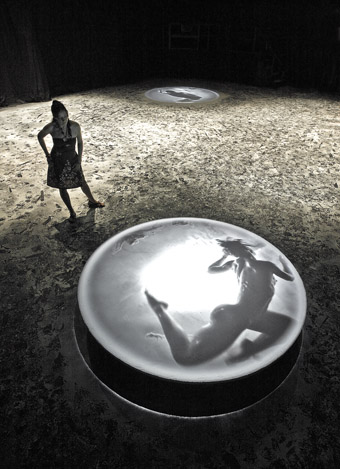interactive mysteries
greg hooper: keith armstrong, gina czarnecki, brisbane festival

Shifting Intimacies
photo David Campbell
Shifting Intimacies
KEITH ARMSTRONG AND GUY WEBSTER COLLABORATED WITH CHARLOTTE VINCENT AND THE DANCER TC HOWARD TO PRODUCE SHIFTING INTIMACIES FOR A SHOW AT THE ICA IN LONDON IN 2006. AT THE BRISBANE FESTIVAL IT IS ON FOR A FEW HOURS SPREAD OVER FOUR DAYS. BOOKINGS MUST BE MADE. SINGLE VIEWER AT A TIME. TEN MINUTE SLOTS. THEY FILL UP PRETTY QUICK.
You turn up at the Judith Wright Centre, grab a drink, sit in the foyer and wait your turn. The usher comes out and quietly offers up the now mandatory fear of litigation instructions on responsible behaviour when encountering an installation. Emboldened by caveats I enter the room alert to the terrors that might lie ahead. The space is darkish and semi-industrial—silver aircon ducts, chunky pillars. Shifting Intimacies was originally designed for ‘the ideal black box’ (painting = the white box; installation = the black box. The white box isolates the object, the black box isolates the viewer). Although it does change the piece from its original conception the space works. There’s something shady and transitory about the combination of slick tech aesthetic and low rent industrial—sort of bump in, bump out biotech.
The floor is covered in white dust marked by the footprints of previous visitors. There are two discs at either end of the space, each one a couple of metres across. The closest disc is a sand covered platform raised to about knee height, the further one a disc of white dust laid out on the ground and defined by a rim of deeper dust. Both discs glow with video projections. Onto the raised disc is projected a dancer, life size, colour muted close to grey scale. The dancer spins and contorts within what looks like a very amniotic fluid. The face is obscured, the body de-identified. Motion is slow, there are pauses then rapid jerking shifts. Tissue filaments, like sheets of skin, float about in the fluid, disintegrate and trail the motion of the limbs. If the raised disc is gestation then the second disc is erosion. Again the dancer is anonymous and seen from above. But this time the image is repeatedly broken down into noise generated by the microbial growth patterns of an AI algorithm. Even though the images are large, the effect is of looking through a porthole or microscope onto a private mystery. The viewer presence is acknowledged but the dancer’s face is always turned away, there is nothing personal or dialogic happening.
Throughout all of this is the sound design—low rumbles, spatially driven static, unnerving resonances. Organic, layered, moving about, buzzes and drones. At times I wander away from the image and just enjoy the sound, which seems to be more responsive to my position in the space than the images ever were. It is as if the sound forms an enclosure within which the dancer acts out a private and necessary cycle.
At the end of the timeslot a light goes on in the corner of the space. One walks up a short flight of stairs to a platform overlooking the disc of the eroded body. But now the body is fully revealed, face down, knees clenched, crouching. You reach into a bowl and grab some dust and cast it onto the figure below. More dust blows in. Soon there is enough dust to erase the figure completely.
Gina Czarnecki’s Contagion provides a very different experience. It is designed around ideas of viral transmission—epidemics of disease and fear. The space is cubic and black, large screen at one end. The screen looks like a giant monocular scope, red crosshairs slowly moving across the surface. Billowing smoke tracks each person’s movement through the space—coloured according to their entrance point and beautifully detailed. And, underneath the smoke trails, a movie of a surveillance operation plays out, figures glowing hot in the long wavelengths of night vision.
Contagion presents a traditional theatric and game-like space with the action split between the presentation on the screen and the audience out front. People try and interact with the system by moving about the space to drive movement in the smoke trails. But one cannot move about the space and interact in a completely natural fashion as the head must be facing forward and angled upward to view the screen, which is quite high. It’s like being in the front row at the pictures. And the look of people all facing the front moving about with their faces craned upward at an uncomfortable angle doesn’t gel with the elegance of the imagery. There is nothing intrinsically wrong with a work that sets up some sort of disjunction or discomfort between action and response, but there must be some sort of conceptually coherent payoff for doing so. Unfortunately in Contagion there is no obvious payoff that links audience motion and orientation to the conceptual domain.
In the end, Contagion feels flat, any emotional or aesthetic engagement dominated by the clumsiness of the interaction. By contrast, Shifting Intimacies does not feel particularly interactive at all—the experience is primarily poetic, and more powerful for that.
Keith Armstrong: www.embodiedmedia.com
Charlotte Vincent: www.vincentdt.com
2008 Brisbane Festival: Shifting Intimacies, artistic directors Keith Armstrong, Charlotte Vincent, sound director Guy Webster, TC Howard, Judith Wright Centre of Contemporary Arts, July 30-Aug 2; Contagion, Gina Czarnecki, The Block, QUT, Brisbane, July 18-Aug 3
RealTime issue #87 Oct-Nov 2008 pg. 35






